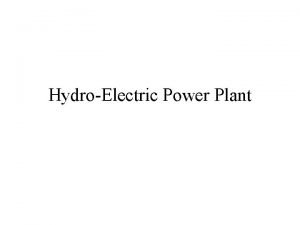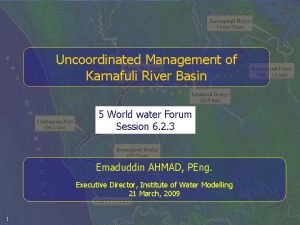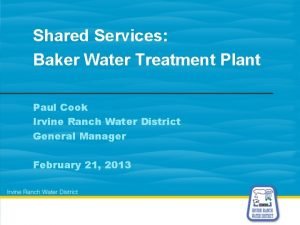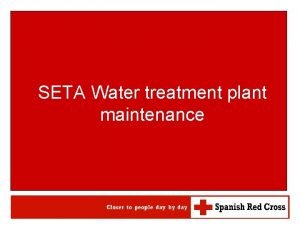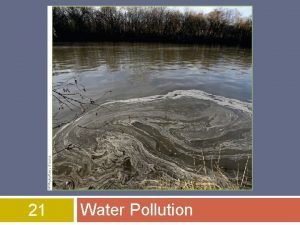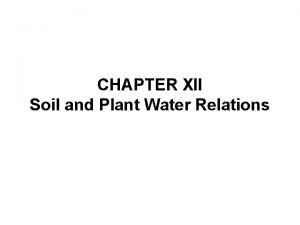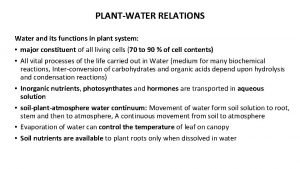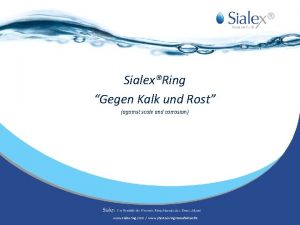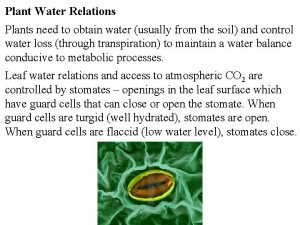Water and Water Relations Rost et al Plant




















- Slides: 20

Water and Water Relations Rost et al. , “Plant biology, ” 2 nd edn Plant Phys and Biotech, Biology 3470 Lecture 3; Jan. 10, 2006 Chapter 10: effects of H 2 O at cellular level

Why is water important to (plant) cells? • • Water constitutes 70% by weight of annual plants Water has multiple roles in plant cells 1. Thermal property: a liquid! • High heat potential: can absorb energy changes without large temperature changes (slows heating and cooling) 2. “Universal” solvent required for mineral uptake and transport 3. It is a requirement for biochemical reactions to proceed • Most enzymes are water soluble

How can H 2 O perform all these functions? • H 2 O has a unique structure • This can result in strong intramolecular attractions • These attractions are due to hydrogen bonds forming between oxygen of one molecule of water and hydrogen from another • Oxygen pulls e- away from H – i. e, it is strongly electronegative – Therefore it has a negative charge (negative dipole) and H have a positive charge (positive dipole) – POLAR Fig. 10. 1 • Forms protective layers around biological macromolecules • Can also occur between polar groups on other molecules…

The plant requirement for water is both a help and a hinderance The paradox of water in plants • Plants need H 2 O to perform photosynthesis, BUT • Gas exchange results in H 2 O loss – Gas exchange involves H 2 O, CO 2 and oxygen • All organisms work to reduce water loss • H 2 O uptake generates turgor – this pressure keeps cells “full” of H 2 O and for plants to remain metabolically competent • Turgor pressure = plant cells pushing against their rigid cell walls Rost et al. , “Plant biology, ” 2 nd edn

The properties of water enable it to perform a wide variety of functions in plant cells • H 2 O is a liquid over the physiologically relevant temperature range for plants – Most other small molecules are gases at ~RT – H-bonding keeps boiling point high • Water possesses a high heat capacity or specific heat – 4. 184 J g-1 ºC-1 → e. g. _______ – water dissipates heat due to its ordered structure in liquid form – This property allows it to redistribute energy • Important in photosynthesis, biochemical reactions • Allows ~ homeothermic environment

Hydrogen bonding between water molecules means that it resists state changes • High heats of fusion and vaporization SOLID → LIQUID → GAS – Due to H-bonding between water molecules • Difficult to change states! – Vaporization cools plant tissue upon evaporation • Energy passed to H 2 O can then leave the surface of the plant

Water serves an essential function in plant mineral nutrition Fig. 10. 2 • Universal solvent – Forms hydration shells around ions – Helps to dissolve by preventing ion reassociation into lattice – Measurable: high DIELECTRIC CONSTANT

Water possesses high tensile strength • We have all seen water striders walking across the surface of water • This is possible because water has a high surface tension • H 2 O molecules stick to each other better than to air → cohesion • Therefore, water possesses high: – Surface tension – Cohesion (“ductability”) – Ability to adhere to solid surfaces http: //www. wonderquest. com/water walk-blueice-magneticpoles. htm Fig. 10. 3

Water on the move: Translocation • H 2 O moves PASSIVELY in plants (no energy used) by two methods: In diffusion, the solute moves from an area of high to low concentration – BULK FLOW – DIFFUSION (a/k/a _______ for water) Bulk flow: • pressure-driven by an external source • a/k/a hydrostatic pressure • governs the movement of water through capillaries • An example of particular relevance is plant vascular tissue, which includes _____ and _____ Diffusion: • directed movement • Driven by concentration differences Increase entropy – High → Low concentration • Diffusion: the solute moves • hyper vs. hypotonic Fig. 10. 4

Osmosis is the movement of water from high to low concentration • In osmosis, the water moves – Diffusion through selectively permeable membrane – Water moves down its concentration gradient – Changes volume of compartments when it moves (note the increase in column height in the second figure) Increase entropy The selectively permeable membrane allows water to pass through but not the solute Fig. 10. 5

Osmosis is passive and driven by active transport of solutes ATP ADP + Pi • Recall that the movement of water does not require the input of energy (e. g. , ATP) • H 2 O only moves when there is a chemical potential through a membrane (= potential to do work) • This occurs when there is a different concentration of solute (and therefore solvent) on either Fig. 10. 6 side • Plants require minerals for nutrition • For example, most of a plant’s nitrogen requirements are met by nitrate in the soil (NO 3 -) • Small mineral molecules are solutes • Solutes are actively transported into root cells via specific transmembrane proteins (e. g. ATPases) • Osmotic adjustment regulates H 2 O concentrations: driven by equalization of concentration on either side of semipermeable (cell!) membrane

The chemical potential of differences in water concentration can be quantified • For any compartment containing water (e. g. , a plant cell!), we can define the term water potential (Ψ) There are many more word definitions of “water potential”! • the ability of a difference in water concentration between two systems (e. g. , inside and outside a cell) to do work • The clearest: a measure of the ability of any object or substance to draw water into itself

The water potential across any barrier is due to solute concentration differences on either side • Like osmometers, cells contain both water and solutes • Think of H 2 O potential Ψ as sum of The availability of water provided by the vascular tissue + The chemical potential of dissolved solute inside the cell to draw in H 2 O • an object (such as a cell wall) that has a negative water potential will draw water into itself from any other object that has a less negative water potential • If a cell is hypertonic relative to its neighboring cells it will have a Ψ < 0; hypotonic, > 0 • By extension, if there are no differences in pressure or solute concentration between cells (no net water movement), the water potential between them is equal to zero

Water potential can be expressed in equation form Pressure potential ≡ hydrostatic pressure Osmotic potential of solute dissolved in the cell Ψ = Ψp + Ψs • From this equation, we can see that the water potential of a cell is proportional to the sum of – The hydrostatic pressure Ψp of water provided by the plant, and – The osmotic potential of the dissolved solute in cell = Ψs

What factors in the plant make up the two terms of the water potential equation? The pressure potential Ψp comes from hydrostatic pressure in the plant • Plant cells are connected to the vascular tissue of the plant • Specifically, the xylem conducts water from the roots to the leaves, where it evaporates from the guard cells • The water column in plants is always moving because plants constantly transpire it is under tension • Plant cells thus constantly acquire and lose water • The hydrostatic pressure is a measure of the tension of the water column • Ψp is higher closer to the vascular tissue and decreases as the water moves through the plant on its way to being transpired • Well-watered plants have a higher Ψp ! • Note that Ψp is always positive in healthy plants

What factors in the plant make up the two terms of the water potential equation? The osmotic potential Ψs of plant cells derives from their dissolved solutes • Solutions of solutes contain osmotic potential (Ψs ) = the ability to draw water from hypotonic solutions by osmosis • High solute concentrations (hypertonic) decrease the osmotic potential of cells (Ψs < 0) Important note! All cells – Have a negative Ψs because they contain solutes – Have a relatively constant Ψs within an organ because they are physiologically similar

The water potential of a cell balances Ψp and Ψs • The water potential of plant cells may be simulated using an osmometer Fig. 10. 7 – These contain a solute in solution – A selectively permeable membrane allows water to enter cell but not for the solute to leave it • If there is a difference in solute concentration on either side of the membrane, there is a chemical potential across it • • Selectively permeable This is its osmotic potential! For hypertonic solutions in an osmometer, H 2 O – Enters tube – Creates pressure – Causes column to rise – A piston in the column can be used to force the liquid in the cylinder back to its original height – It can also measure the pressure required proportional to Ψp ! – The Ψs is inferred from the concentration of solute inside Together, this information provides a measure of the Ψ of the system

Water potential relates to entropy • In any system (osmometers, cells), Ψ tends towards 0 • Equilibrating the water potential on either side of a membrane maximizes entropy – The combination of high hydrostatic pressure outside the cell and the cell’s hypertonic cytoplasm causes the passive flow of water inside by osmosis • This ↑ hydrostatic pressure Ψp inside the cell • The increase in Ψp balances the negative Ψs – Ψ thus tends to 0 → this slows the import of H 2 O • Water potential is < 0 in cells in transpiring plants

Relating osmometers to plant cells H 2 O moves along concentration gradients between cells Fig. 10. 9 Fig. 10. 8 • Individual cells are consistently hypertonic – thus Ψs is ~ constant • Hydrostatic pressure Ψp ↑ the closer the cell is to the xylem vessel • Sum creates Ψ gradient • Therefore, H 2 O moves through cells • Cells plasmolyze as their water content decreases • Plant cells do not plasmolyze this much in vivo: Ψs ~ constant • The cytoplasm pushes against rigid cell walls → allows turgor pressure to develop • Ψp varies and contributes most to change in Ψ

Intracellular solute concentration can be changed and contributes to the regulation of Ψ • Solute concentration in a cell may be increased through active transport of ions inside the cell – via membrane transporters/ATPases • This decreases Ψs and thus decreases Ψ – cells have lower water potential than does surrounding water • Increasing solute concentration in cells causes water to diffuse in due to osmotic gradient, thus increasing Ψ p! • Hence the balancing act! • Ψ in all biological systems tends to zero, but is prevented from doing so by metabolism (e. g. , active transport of ions/minerals into cells, powered by coupled ATP utilization).
 Friedrich rost
Friedrich rost Kommutativlik
Kommutativlik összekuszált növényi rost
összekuszált növényi rost Lazarostos kötőszövet kép
Lazarostos kötőszövet kép Water and water and water water
Water and water and water water Water relations in plant cells worksheet answers
Water relations in plant cells worksheet answers Employee relations in public relations
Employee relations in public relations Tronsmo plant pathology and plant diseases download
Tronsmo plant pathology and plant diseases download Tronsmo plant pathology and plant diseases download
Tronsmo plant pathology and plant diseases download Tronsmo plant pathology and plant diseases download
Tronsmo plant pathology and plant diseases download Objective of plant breeding
Objective of plant breeding Taichum
Taichum Plant introduction in plant breeding
Plant introduction in plant breeding Thermal power plant introduction
Thermal power plant introduction Atlanta rm clayton water reclamation plant
Atlanta rm clayton water reclamation plant Mohra water treatment plant
Mohra water treatment plant Which tissue transports water around a plant?
Which tissue transports water around a plant? Which tissue transports water around a plant?
Which tissue transports water around a plant? Baker water treatment plant
Baker water treatment plant Water treatment plant
Water treatment plant Water treated from sewage treatment plant
Water treated from sewage treatment plant













